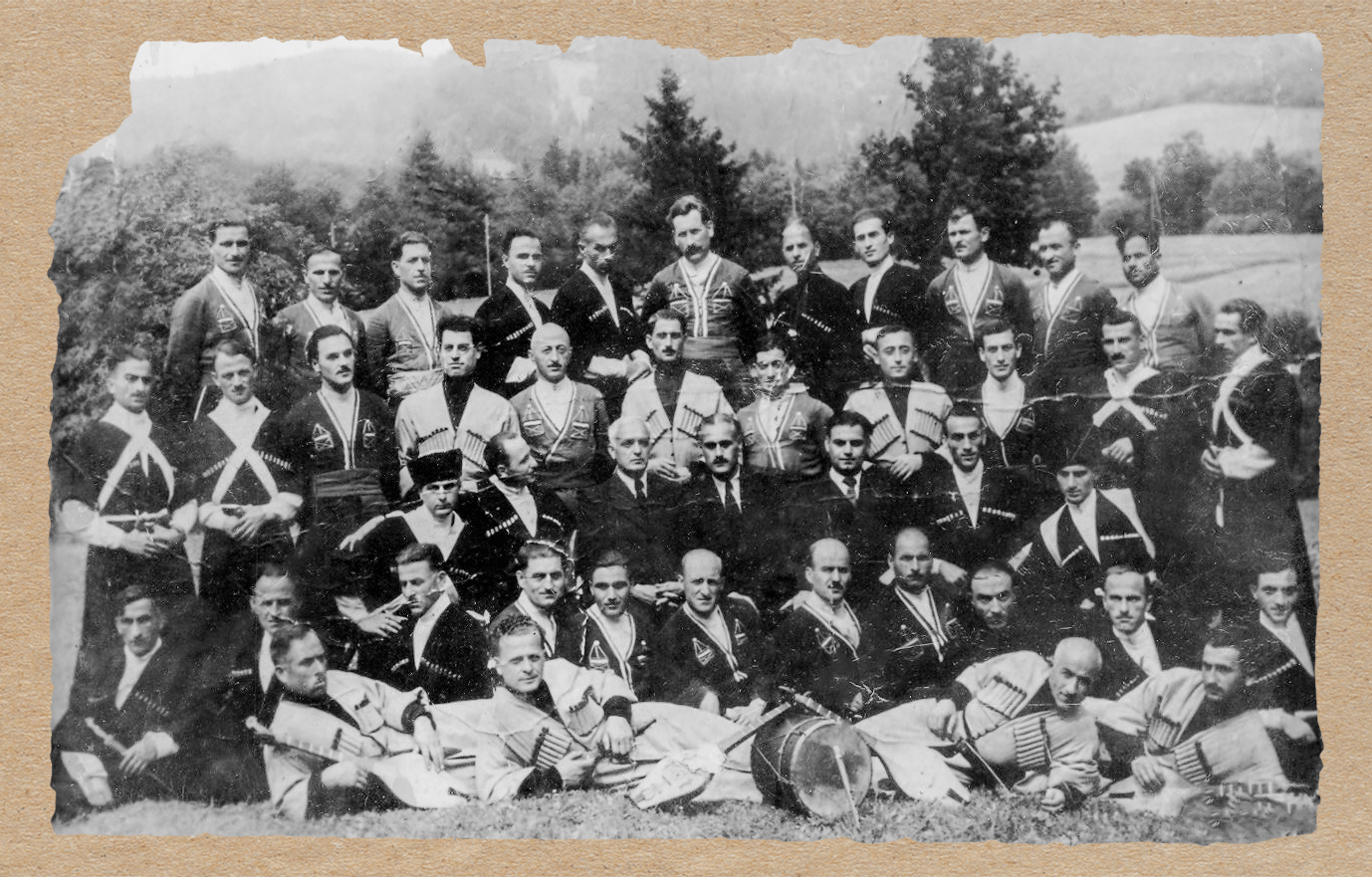Saved by Singing
At first glance, you might think that this photo shows a Georgian ethnographic ensemble: some are dressed in traditional Gurian clothes, some in Abkhazian, some in Kakhetian. In fact, however, this is a group of Georgian prisoners of war. It all started like this ...
At the end of 1941, Datashka Kavsadze, one of the leaders of the Georgian state folk song and dance ensemble, a son of the famous choirmaster Sandro Kavsadze, was called up for war. His brother, Gigusha Kavsadze, also a singer, was killed during a fierce battle on the Kerch Peninsula, in the Crimea, while Datashka himself was captured and held in a concentration camp.
At that time, captives with relatives in Europe were being released by the Nazi authorities. Datashka's comrade, Valodia Kharbedia, was among those released, since he had relatives among the Georgian emigrés who had fled Soviet occupation in France. From Valodia, the Georgians of Paris found out that Datashka Kavsadze was in captivity. Through their diligent efforts, Datashka was also released from the concentration camp.
In Paris, someone had the idea of creating a Georgian ensemble from the ranks of the prisoners of war. This was an excellent opportunity to free and rescue Georgian captives. Returning to the camps, Datashka convinced the Germans of the need for more people for the group, selecting men regardless of musical background or ethnicity, and thus freeing them from the harsh conditions of captivity. Among those released were Georgian Azerbaijanis, Armenians from Georgia, and Georgian Jews, among others.
The newly formed ensemble soon achieved success. They put on many concerts and were even invited to the United States in 1945. After the end of the war, however, Datashka decided to return to his homeland. This decision turned out to be fatal: he was arrested en route. His children, Kakhi and Imeri Kavsadze, saw their missing father for the first and last time in a detention cell, after the war. Charging him with treason, Soviet authorities deported him to Siberia, a journey from which he never returned. Datashka Kavsadze died in 1952, at age forty-five. He may have been shot. The location of his grave remains unknown.
This photo of the POW ensemble somehow reached the hands of the Kavsadze family before Datashka returned to his homeland from France. When the security services came to search Datashka’s family, his wife Tamar Tsagareishvili kept the photo in her breast pocket, and thus it was not destroyed. According to the memoirs of Datashka's son, the famous actor Kakhi Kavsadze, many people would later visit their family to look at the photo. They were searching for their family members among the captives in the photo, trying to identify their missing relatives: sons, brothers, husbands …
This unique photo of Datashka Kavsadze's Georgian POW ensemble is, unfortunately, the only one. It is possible that other documents related to the choir’s work might be stored in an archive in France, waiting to be discovered by an interested researcher.
Photo: Datashka Kavsadze in the center of the third row.
Source: The Kavsadzes (Monograph). 2007. Tbilisi: Folklore State Centre.

%20%E1%83%A1%E1%83%90%E1%83%9C%E1%83%93%E1%83%A0%E1%83%9D%20%E1%83%9C%E1%83%90%E1%83%97%E1%83%90%E1%83%AB%E1%83%94%20-%20%E1%83%9E%E1%83%A0%E1%83%9D%E1%83%94%E1%83%A5%E1%83%A2%E1%83%98%E1%83%A1%20%E1%83%AE%E1%83%94%E1%83%9A%E1%83%9B%E1%83%AB%E1%83%A6%E1%83%95%E1%83%90%E1%83%9C%E1%83%94%E1%83%9A%E1%83%98%2C%20%E1%83%A1%E1%83%90%E1%83%A0%E1%83%94%E1%83%93%E1%83%90%E1%83%A5%E1%83%AA%E1%83%98%E1%83%9D%20%E1%83%A1%E1%83%90%E1%83%91%E1%83%AD%E1%83%9D%E1%83%A1%20%E1%83%AC%E1%83%94%E1%83%95%E1%83%A0%E1%83%98-min.jpg)
%20%E1%83%97%E1%83%94%E1%83%9D%E1%83%9C%E1%83%90%20%E1%83%A0%E1%83%A3%E1%83%AE%E1%83%90%E1%83%AB%E1%83%94%20-%20%E1%83%A1%E1%83%90%E1%83%A0%E1%83%94%E1%83%93%E1%83%90%E1%83%A5%E1%83%AA%E1%83%98%E1%83%9D%20%E1%83%A1%E1%83%90%E1%83%91%E1%83%AD%E1%83%9D%E1%83%A1%20%E1%83%AC%E1%83%94%E1%83%95%E1%83%A0%E1%83%98-min.jpg)

